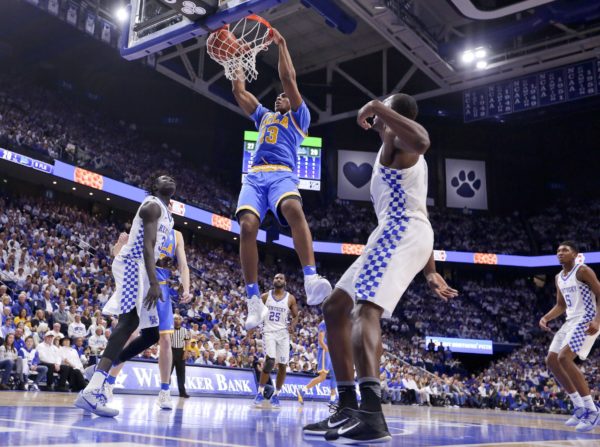In Hoops We Trust: Blue-Blooded Season
Posted by Joshua Lars Weill on December 15th, 2016One of the biggest changes in college hoops over the last 10 years has been the rise of several consistently strong mid-major programs to the status of legitimate national title contenders. George Mason first crashed the Final Four party in 2006 with a gutsy, emotional Elite Eight win over #1 seed Connecticut. That paved the way for the rise of Butler (2010, 2011), VCU (2011), and Wichita State (2013), each of which were led by dynamic young coaches building winning programs. Throw in the likes of Gonzaga, San Diego State and Xavier, and the growing parity brought with it added competitiveness and a widening of the NCAA hoops pie. But this year is all about the blue-bloods. Kentucky, Duke, Indiana, Kansas, North Carolina and UCLA are all in the AP top 10 for the first time since 1994. While some of those schools have maintained relevance over the intervening seasons, the simultaneous rise of the Hoosiers and Bruins augurs a shift back to the traditional power programs.
The “why” for this trend could very well be recruiting. Kentucky’s John Calipari was the first coach to truly embrace the one-and-done model of recruiting. The theory is basically that if you can gather the most talented players in the country — regardless whether all of them will be headed to the NBA after just one season — you should. Yes, there are challenges with youth, inexperience and with program continuity, but he proved with the 2012 National Championship and four Final Fours in five years that if you recruit the best players, challenge them in practice, and preach selflessness and defense, you can win. Mike Krzyzewski noticed and Duke jumped on board. Roy Williams also has a slew of McDonald’s All-Americans, and Bill Self has never shied away from recruiting one-year talents regardless of whether he plays them. UCLA this season joined the party with a pair of freshman All-Americans in Lonzo Ball and TJ Leaf. So far, Steve Alford‘s accumulation of talent has helped transform a formerly teetering program into the current #2 team in the country.
Conventional wisdom once held that experience trumps talent in the NCAA Tournament. This was the rationale for the VCUs, Butlers and Wichita States of the game. But as major programs blend experienced returnees with those talented NBA prospects, they often overwhelm their less athletic, overachieving rivals. So, does this early trend hold? That remains to be seen. Perhaps those talented freshmen will revert to traditional norms or hit the rookie wall as the long season works its way into spring. Or perhaps injuries will take a toll. Or maybe some of those power programs in smaller conferences will again crash the party. It wouldn’t be a shock. But so far this season, it’s been a feast for the rich. How fat they get we shall know in good time.
POINTING UP
All season long, NBA scouts flock to college games in search of the next big thing. It seems as if this year they’ll be looking at the next big “small” thing. The cream of the NBA Draft crop mostly consists of point and “combo” guards. Dynamic, game-changing, unafraid, and ambitious, this core group of guards is pushing to the top of the 2017 mock draft boards.
They are led by Washington guard Markelle Fultz. Fultz was a late bloomer in high school who has now blossomed. He is the only freshman in the country who currently ranks among the top 50 scorers at over 22 points a game; he shoots better than 49 percent from both the field and behind the arc; and, he’s also adding seven boards, six assists, and two steals to boot. The problem for Fultz is that he may be sitting out the NCAA Tournament unless his teammates can coalesce around him into an actual team. Right now, Fultz is on the Ben Simmons at LSU track, and that can become a drag on general perceptions of a player’s ability to win within a team framework.
UCLA’s Lonzo Ball has helped put the Bruins back on the map. Second in the nation with nearly nine assists per game and shooting a surprising 45 percent from three-point range despite an odd-looking release, Ball has been the catalyst for UCLA’s undefeated start. Often compared to Jason Kidd, Ball lacks the extreme athleticism common in NBA point guards today, but his play to date implies his skill level is so high it may not matter.
While Fultz and Ball have shown their value as centerpieces of their teams, the most athletic star freshman point guard is undoubtedly N.C. State’s Dennis Smith. Standing a listed 6’2”, Smith routinely makes plays well above the rim. After a slow start, he’s now the Wolfpack’s leading scorer at just over 18 points per contest. As the season moves along, his performance in the always-loaded ACC may be a way for him to show he belongs in the conversation for the top few picks.
Finally, Kentucky’s De’Aaron Fox may be the fastest end-to-end player in college hoops in years. Rated the #1 or #2 point guard coming out of his Houston high school, Fox has not missed a beat as Calipari’s latest star one-guard at Kentucky. He’s averaging nearly 15 points and seven assists per game while driving a Wildcats’ offense that is averaging a robust 94 points every outing. The knock on Fox is that he can’t shoot. While his form isn’t horrible, results are results. Until he can hit a three-pointer with any degree of consistency, he will struggle to move ahead of his colleagues on this list.
All in all, this year’s crop of freshman point guards looks to be the best in years, and the NBA surely notices. Enjoy them while they’re in school, because they’ll be slithering past defenders in the pros by this time next year.











































